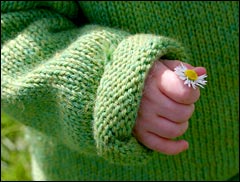Dear Umbra,
I have just recently learned about all these plastic-awareness issues and now wonder about polyester clothing, or any human-made fabric for that matter, on my children (three girls: 3, 5, and 7 years old). If plastics can leach out into their bodies, can clothing also affect them?
Julie Roberts
Nevada City, Calif.
Dearest Julie,
The clothing we wear can affect all of us, as well as our environment. But should you be scared for your nylon- and polyester-clad children? Probably not.

Don’t sweater the small stuff.
Photo: iStockphoto
As I’ve written before, environmentally speaking, natural and synthetic clothing are roughly the same in terms of the toxicity of turning raw materials into wearable clothing. They both have their downsides. Those downsides tend to involve chemicals that you wouldn’t normally choose to have near your (or your children’s) skin: formaldehyde, sulfuric acid, and the like. But according to the “experts,” it’s rare for the body to absorb chemicals directly from clothes.
To be perfectly honest, I don’t know how much the experts have studied this question. I do know that some of the bigger environmental organizations, like Greenpeace and the World Wildlife Fund, have spoken out about chemicals in kids’ clothes in the past. And as the Associated Press reported just last month, many parents are turning to organic clothes for their little ones. From 2004 to 2005, the organic-fiber market for infants grew 40 percent, to $40 million, and the market for children and teens grew 52 percent, to $3 million. I also know that chemical sensitivities to different substances — including synthetic materials — are not all that unusual.
So if you’re still concerned, there are several things you can do. First, think about buying more natural fibers like wool, hemp, and cotton. You will find a bounty of organic and sustainable clothing companies if you spend time poking around on ye olde internet. But you don’t have to go on a treasure hunt: even natural-fiber clothes that are industrially produced share admirable aspects with their sustainable cousins. They don’t generate much static electricity in the dryer (so those toxic dryer sheets aren’t needed), they generally require less (or no) toxic dry cleaning, they’re made from renewable resources, and after you’re done with them (and they can no longer be reused), they can be composted. Try doing that with your polyester leisure suit! (Actually, please don’t.)
I suppose you could go the Gandhi route and make your own clothes. But I’m guessing a mother of three might not have time for that kind of thing. So here’s another trick: buy from secondhand shops. This way you will not only adhere to the second R in the recycling triad, but you’ll give the clothes time to offgas the various toxins they were birthed or bathed in during manufacture.
If you do stick with buying new synthetic fabrics, know that they generally get less off-gassy and chemical-soupy with time due to the effects of age, wear, and multiple washings. (The one thing I must insist you avoid is PVC items like ponchos and cheap raingear. Remember our by-now-familiar motto: No vinyl, that’s final!)
Whatever kind of clothing you buy, make sure to wash all new-to-you duds with natural laundry soap at least once before wearing. This will help get out any residues from its manufacture or from previous washings in chemical-rific mainstream detergents.
Sartorially,
Umbra

